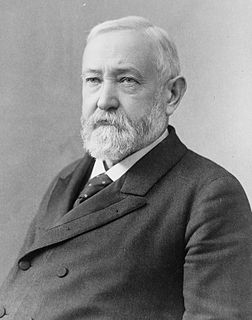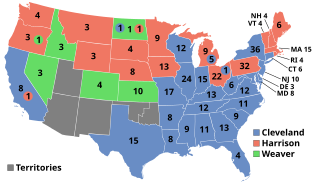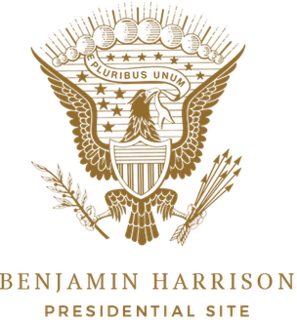 W
WBenjamin Harrison was an American politician and lawyer who served as the 23rd president of the United States from 1889 to 1893. He was a grandson of the ninth president, William Henry Harrison, creating the only grandfather–grandson duo to have held the office. He was also a great-grandson of Benjamin Harrison V, a founding father who signed the United States Declaration of Independence.
 W
WThe 1892 United States presidential election was the 27th quadrennial presidential election, held on Tuesday, November 8, 1892. In a rematch of the closely contested 1888 presidential election, former Democratic President Grover Cleveland defeated incumbent Republican President Benjamin Harrison. Cleveland's victory made him the first and to date only person in American history to be elected to a non-consecutive second presidential term. It was also the first of two times that an incumbent was defeated in two consecutive elections.
 W
WAngel of the Resurrection is a massive stained glass window by the American Art Nouveau glass manufacturer Tiffany Studios, now in the collection of the Indianapolis Museum of Art. It was commissioned by former-First Lady Mary Lord Harrison as a memorial to her husband, President Benjamin Harrison. Completed in 1904, the window depicts the Archangel Michael calling for the dead to rise at the Second Coming.
 W
WBenjamin Harrison is a public artwork by American artist Charles Henry Niehaus, located in University Park in downtown Indianapolis, Indiana, United States. It is a full-length bronze sculptural portrait of 23rd President of the United States, the only U.S. President from Indiana.
 W
WThe Benjamin Harrison Memorial Bridge is a vertical-lift bridge that spans the James River between Jordan's Point in Prince George County and Charles City County near Hopewell, Virginia. The bridge carries vehicle traffic of State Route 106 and State Route 156, and is owned by the Virginia Department of Transportation (VDOT). It is named after Benjamin Harrison V, a signer of the Declaration of Independence and a Governor of Virginia, who lived nearby at Berkeley Plantation.
 W
WBenjamin Harrison is a bust by American artist Richard Peglow, located in the north atrium on the second floor of the Indiana Statehouse, which is in Indianapolis, Indiana, United States. The bust is cast in bronze and depicts President Benjamin Harrison. The bust is placed in front of a grey and black marble shield with six stars tracing around the edge of the shape. The bust and shield are approximately 28 inches (710 mm) wide by 25 inches (640 mm) high and has a depth of 14.5 inches (370 mm). The artwork was cast and placed in the statehouse in 2008 in accordance with Indiana code Section 2. IC 4-20.5-6-12.
 W
WPresident of the United States Grover Cleveland's first term (1885-1889) was most notable "for its record number of vetoes (414), more than double the number issued by all his predecessors combined." During Cleveland's first term, controlling Congressional and "wasteful spending" was an important priority for him and his administration. Cleveland's vetoes angered the Grand Army of the Republic (GAR), a powerful organization advocating for Union veterans. In his State of the Union Address in December 1887, President Cleveland called for lower tariffs and tariff reform, making it a major issue in the upcoming 1888 U.S. Presidential election.
 W
WAfter losing re-election to Republican Benjamin Harrison in 1888 and leaving office in 1889, U.S. President Grover Cleveland was initially satisfied with his return to private life. However, Cleveland's views about his retirement began to change at the time of the 1890 midterm elections, in which the Democrats won huge victories at the ballot box. In addition, Cleveland disliked what he perceived to be the frequent blunders of the Harrison administration. By the time 1891 ended, Grover Cleveland decided to re-enter American political life and run again for U.S. President in the 1892 U.S. Presidential election.
 W
WThe Benjamin Harrison Presidential Site, previously known as the Benjamin Harrison Home, was the home of the Twenty-third President of the United States, Benjamin Harrison. It is in the Old Northside Historic District of Indianapolis, Indiana. Harrison had the sixteen-room house with its red brick exterior built in the 1870s. It was from the front porch of the house that Harrison instituted his famous Front Porch Campaign in the 1888 United States Presidential Campaign, often speaking to crowds on the street. In 1896, Harrison renovated the house and added electricity. He died there in a second story bedroom in 1901. Today it is owned by the Arthur Jordan Foundation and operated as a museum to the former president by the Benjamin Harrison Foundation.
 W
WCaroline Lavinia Harrison, was a teacher of music, the wife of Benjamin Harrison and mother of two surviving children; after his election as President of the United States, she was the First Lady of the United States from 1889 until her death.
 W
WMary Dimmick Harrison was the second wife of the 23rd United States president Benjamin Harrison. She was nearly 25 years younger than Harrison, and was the niece of his first wife.
 W
WMary Scott Harrison McKee was the only daughter of President Benjamin Harrison and his wife Caroline Scott Harrison. After her mother died in 1892, McKee served as her father's de facto First Lady for the remainder of his term.
 W
WElizabeth Harrison was the third of three surviving children of U.S. President Benjamin Harrison, and the only child of his second wife, Mary Scott Lord Dimmick.